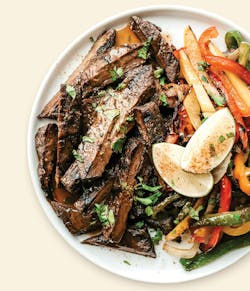Plant, animal and novel protein sources all battle for a place on consumers’ plates. Deal-breakers for a food’s acceptance include cost, convenience, sustainability and nutrition, but flavor usually surpasses all.
Undesirable flavors contributed by plant proteins are an often-mentioned industry challenge. But it’s a challenge that can be overcome with the right tactics and food science.
Land Lovers is a new company off to a great start. The company’s soy- and wheat protein-based alternative meats have garnered praise. For example, its Mongolian Plant-Based Steak (pictured at the top) won a 2023 National Restaurant Assn. FABI Award (under the company’s previous name, Alchemeat).
Huan Xia, co-founder and CEO, explains how Land Lovers products, sold as unflavored frozen textured plant protein components, differentiate themselves in a competitive category. Land Lovers has a patented high moisture extrusion process. Still, Xia quickly adds that the university where she earned a Ph.D. in food science has many patents “just sitting there.” Much more is needed to drive a successful business.
“We focus on product cost and taste, which are the most important attributes,” Xia says. We need to be profitable. Venture capital is helpful, but we don’t want to burn through it. Our production process is scalable and can already manufacture, on average, some 6,700 lbs./day. She adds that the product is at cost parity with beef in the marketplace, even at this early stage.
Other product advantages include nutrition — a high protein digestibility-corrected amino acid score (PDCAAS) helps it qualify for the USDA’s Child Nutrition Program. Good customer margins can be obtained due in part to minimal product shrinkage and, in some cases, a gain of 10-15% weight as it picks up water when cooked. As for texture, the protein fibers are very similar to muscle, which gives a realistic bite.
“It’s elastic and gradually degrades in the mouth, allowing one to savor the flavor and helping to give the impression that it is steak,” Xia relays.
Regarding taste, Land Lovers provides dozens of recipes for its foodservice clients. Beyond Mongolian Plant-Based Steak, others include Peruvian, Cuban and Asian dishes, ravioli, pot pies and Philly cheese steak.
While chefs turn Land Lovers proteins into culinary winners, product developers formulating products from scratch — especially those manufactured at a large commercial scale — need a knowledgeable, systematic approach to flavoring foods and beverages with higher protein levels.
Proteins with minimal flavor of their own, another product benefit touted by Xia, are a vital starting place for a great-tasting finished food.
Little flavor: It’s a good thing
Flavoring high-protein foods and beverages is difficult due to inherent off-flavors from protein ingredients and unwanted interactions they undergo with flavorings, says Robert McGorrin, professor of flavor chemistry in the Food Science & Technology Dept. of Oregon State University.
Helping to define flavor, McGorrin explains that the perception of flavor is triggered by volatile aromas (e.g., cherry, smoky), tastants (e.g., sweet, savory) and chemesthesis, which detect chemical irritants by cutaneous neurons. Examples include pepper burn, menthol cooling or astringency.
Plant proteins are not alone in contributing undesirable flavors. The issue also extends to dairy protein ingredients, although perhaps to a lesser degree since they are rarely asked to mimic non-dairy proteins.
One aspect of the challenge is flavor variability among different protein sources. “Even the same protein, such as a milk, pea or a soy concentrate, but from different suppliers will have different flavor profiles,” says MaryAnne Drake, WNR Professor at North Carolina State University and director at the Southeast Dairy Foods Research Center.
For example, whey protein isolates can differ in the intensities of cardboard and cabbage flavors and bitterness or astringency. These are protein-specific flavors. The more dairy protein added, the more potential for protein-specific flavors (not typically associated with dairy) in the product.
Thus, bland is better. “In one study with a series of peach beverages containing 10% whey concentrate (WPC of 80% protein) from different suppliers, the beverage made from the mildest protein with the least carry-through to the beverage was the most preferred,” says Drake. Not surprisingly.
As expected, more significant flavor variability occurs between ingredient categories, such as dairy versus pea or almond protein. Plant proteins have an extensive range of flavors because they come from a wide array of plants.
Causes of protein ingredient off flavors
“Lipid oxidation and sulfur degradation products are the primary sources of flavor in dried dairy protein ingredients,” continues Drake. These compounds vary between types of dairy proteins. They are also a primary cause of flavor issues in plant proteins.
Maillard reactions play an important role at higher storage temperatures and with dairy ingredients of higher lactose levels. At room temperature, these reactions are more significant in milk protein flavor degradation than in whey.
Factors contributing to off-flavors from cheese-derived whey include the cheesemaking process (e.g., cultures used), protein manufacture unit operations (e.g., spray drying) and storage. “Shelf stability is not infinite, no matter the source,” cautions Drake. What the end user does is crucial. For example, instantization/agglomeration of a powder shortens shelf life by roughly three to five months.
Food processors also must remember that an ingredient’s shelf life usually includes its time in raw material storage and in a finished product.
Beyond the innate reactions contributing to off-flavors, McGorrin describes how flavoring-protein interactions can cause a flavor profile to become unbalanced due to selective binding with only certain aromatic chemicals or to experience flavor fade. This includes flavor absorption (usually reversible) and flavor binding (nonreversible covalent bond formation) that inhibit the release of aroma compounds bound with proteins into the gas phase for flavor perception.
A classic case of flavor binding occurs when an aldehyde such as vanillin (the characterizing molecule in vanilla) binds with certain protein amino groups. One study found that the most significant flavor fade occurred with a 3% solution of bovine serum albumin, less so with a 3% solution of sodium caseinate, and the least with a 3% whey protein isolate solution.
Flavor additions get closer to the goal
As understanding of how flavors “go wrong” increases, so does knowledge of tactics to mitigate issues. Webb Girard, senior director of R&D at the product development firm Culinex offers examples and strategies to consider.
"Plant-based 'meats' are some of the most difficult products to flavor," concurs Girard. Awareness of the flavor pyramid helps maximize product development time while getting the most out of flavoring components. “Otherwise, you’re adding flavors just to add flavor.”
Start with base notes, which provide savory, non-specific meaty, umami and “mouthfeel” elements, Girard advises. Sources are yeast extracts and reaction flavors. Once the base notes are established, add protein-specific mid notes (e.g., chicken, beef), which yeast extracts and flavorings can provide. Finally, layer in the top notes. Examples include grilled, seared, smoked and caramelized.
As the formula is developed, “feather in” flavors so one isn’t unduly pronounced. The Culinex staff has found marketplace products with strong yeast extract flavors. “The developers just ‘went for the gusto,’ but the products weren’t as good as they could be,” says Girard.
“The order in which the layers are added during formula development is important,” Girard warns. Some start with a top note, like a grilled flavor for a burger. The base flavor is considered later or not at all. “This doesn’t work,” he states without reservation.
Flavor modulation is especially important for plant proteins due to their pronounced flavor. Three methods can be considered. Maskers lower the perception of undesirable flavors by distracting with aromas, flavors or sensations.
Second, blockers change the interaction between a food flavoring component and a taste receptor, which inhibits taste. Based on experience from many R&D projects, “It is hard to find the right one as every company has its blockers; they work differently,” says Girard.
Third, enhancers increase the perception of other flavors. A practical application would be monk fruit sweeteners to block undesired notes and enhance wanted ones in legumes and cereals.
Masking mechanisms
McGorrin delves into details of masking tactics. In a “flavor congruency” strategy, choose a flavor system that contains the same off-flavors present in the protein ingredient. Thus, peanut or nut flavors help mask earthy notes in pea protein or the beany notes in soy. In a “flavor insertion” strategy, undesirable notes complete a flavor system. The “green notes” from soy protein can improve a strawberry flavor lacking green notes. A downside to both these strategies is that they limit flavor choices.
As for modulating bitterness, increasing sweetness is a common tactic. Alternatively, beta-blockers such as sodium chloride (table salt), monosodium glutamate (MSG), adenosine monophosphate (AMP) or proprietary blockers can be used.
Astringency is not an aromatic flavor compound or tastant but a mouth-drying sensation. It can be a challenge in whey beverages. Increasing a product’s pH above 3.5 decreases astringency but may also reduce heat stability, clarity and potentially food safety if carried too far. Another option to try is the addition of larger molecule carbohydrates, such as gums and soluble fiber.
McGorrin and Girard recommend that R&D staff work with their flavor supplier early in the product development process. McGorrin adds that providing as much information as possible is desirable. Key pieces of data include a product's protein level, moisture content, pH, the presence of sweeteners (both natural and high potency) and vitamins. Disclosing heat processes and what upper temperatures are reached is also helpful.
Girard addresses an issue entrepreneurs and smaller processors may face: getting the attention of a flavor house. “If permitted by the supplier, we’ve found one of the easiest approaches is to co-develop a product at their facility,” he says. “When you’re right on site, you often can get the attention of more scientists. For example, depending on your size, they may be able to offer descriptive panels.”
The flavor of high-protein foods and beverages has greatly improved over the years. Looking to the future, McGorrin advises that additional research is needed in flavor-protein interactions to better understand what types of food proteins are more reactive with certain classes of flavor compounds and how their reaction rates vary under different processing conditions.




